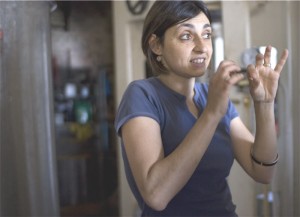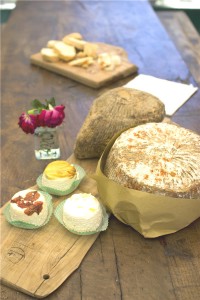For the Beltramis, making olive oil and cheese is a family affair

In the Rusticucci Palace, once owned by a 15th century cardinal and now the Beltrami family’s olive oil factory, Cristiana Beltrami explains the process of making the oil. The family is also known for its cheese: Italian-American chef Lidia Bastianich has called Cristiana's father, Vittorio, the “Einstein of Cheese.” (photo by Elizabeth Zabel)
“Ciao!” says the short, elderly woman standing behind the counter. On her apron are the words “Gastronomia Beltrami, Cartoceto, Italy.” This is Elide Beltrami, wife of Vittorio Beltrami, a man who has been ordained the “Einstein of cheese” by famous chef Lidia Matticchio Bastianich. With a wide, warm smile, Elide makes me feel as welcome as if I were walking into my local corner store.
However, Gastronomia Beltrami is not just your average corner store. Inside the front glass case are piles of pecorino cheese, made from the milk of the Beltramis’ sheep. To the left, stacked on wooden shelves, are jars of fig and other fruit jams, made by Elide and her family and wrapped in brown paper and ribbon. Lastly, on a wide oak cupboard are bottles of glistening green olive oil—a product that brought this family name much praise in the early 1900s—harvested from the Beltramis’ groves and pressed in a 500-year-old palace.
A petite woman in her mid-thirties with short dark-brown hair comes from the back and flashes a smile. This is Cristiana Beltrami, the daughter of Vittorio and Elide Beltrami. “Let’s go on a tour,” she says and I follow her to her car. As she drives, Cristiana explains that she has worked at the shop for 15 years, since graduating with a degree in economics from the University of Urbino.
[pullquote] Our history is in the job that we do, we have roots; a culture.[/pullquote] Our first stop overlooks the town; the view is filled with olive trees, churches, hills, and fields. Cartoceto is located in the Marche region and is a municipality in the province of Pesaro and Urbino. Cristiana explains that Cartoceto is part of an association called “Città Dell’Olio”—City of Oil—because of the town’s large production of olive oil. The Marche region, she explains, was a church territory in the 1500s, with a lot of priests, churches, and monasteries. “The olive oil produced in this area would all go to Rome.”
The Beltramis have been among the region’s olive growers since 1870. In the 1960s, Vittorio’s father, Quindi, opened a tabacchi store that sold everything including the family-made olive oil. Vittorio and Elide took over the business in 1980 and named it Gastronomia Beltrami, adding cheese and jams. These days, the family grows 20 different varieties of olives in a secluded area called “Covo dei Briganti”—hideout of bandits—where men once took refuge to avoid joining the military. Once a week, the olives are picked by hand. These olives are then taken back to town to be pressed in the old Rusticucci Palace, originally owned by a cardinal in the 1500s, to create the final product, extra virgin olive oil.

Every year, the Beltramis hold a celebration to unveil their new formaggio di fossa. (photo by Elizabeth Zabel)
Fast forward to 1980, when Vittorio Beltrami brought in something else: formaggio di fossa; in English, “pit cheese.” This form of making cheese has its roots in the Marche. According to Ashley Bartner, a food expert living in the region, in the 1400s farmers stashed their cheese in caves to hide it from raiding soldiers. After the soldiers left, the farmers retrieved their hidden cheese only to find it not only edible but delicious because of the constant temperature. It has a musty smell, a sharp taste, and a crumbly texture. The Beltramis’ version of this cheese has been featured in festivals such as Slow Food International and Milano Food. Lidia Bastianich, American chef, restaurateur, and author specializing in Italian food, even did a segment on Vittorio Beltrami on her PBS show, “Lidia’s Italy.”
We stop at the “Covo dei Briganti,” where the Beltramis’ goats and sheep roam the countryside, eating the grass, and living “completely in symbiosis with nature,” Cristiana explains. Vittorio hand-picks the sheep and goats, she says, to assure the best cheese. He travels all over Italy to find the animals, brings them back to the pasture, and names each one. Cristiana points to some of the goats nearby, reciting their names: Mansueto, Bianchina, and Bella. Eric LeMay, professor at Ohio University and author of the book Immortal Milk: Adventures in Cheese, describes Vittorio Beltrami as a man who “has a true investment in the land, the animals, and co-workers, and he’s not afraid to stand up for tradition and against those who would compromise it.”
Our next stop is the Rusticucci Palace, where Cristiana describes the process of making the formaggio di fossa. Each August, Vittorio puts the formaggio di fossa into cloth bags filled with herbs and stores it in a dark, cold cave beneath the Rusticucci Palace, leaving it to mature until November. After three months, the Beltramis unveil the buried cheese in an annual ceremony. Visitors come from all over Italy to see and taste the new cheese.
Driving back to the store, Cristiana says, “For me, my family is very important and this was a choice of life.” The family uses the word retroinnovazione to sum up what they do. This term means remembering the past and never forgetting it. However, it also means using the principles of the past in the present and the future. “Our history is in the job that we do, we have roots; a culture. Here we run a real economy because we make the products from start to finish,” Cristiana says.
Back at the store, Cristiana and Elide bring out a platter of two types of formaggio di fossa, white wine, and focaccia bread. One “fossa” is older and tastes strong. The other, a young fossa, is fresh and light. The savory tastes of the cheese and foccacia fit perfectly with the sweet taste of the wine. Next Elide serves fresh yogurt with berry jam in a small cup. I savor every bite. Elide asks, “Ti piace?” “Do you like it?”
“Si, buonissimo!”
Gastronomia Beltrami
Via Umberto I, 21-23
61030 Cartoceto, Italy
0721 893 006
gastronomiabeltrami@alice.it
gastronomiabeltrami.comOpen Tuesday through Saturday 9 a.m.-1 p.m. and 4:30-7:30 p.m.
Open Sunday and Monday by appointment only.
This article is from Urbino Now magazine’s Mangia Bene section, which explores the ingredients, cuisine, and food traditions that distinguish Urbino and the Le Marche region. Please view more magazine articles or order a complete printed copy of Urbino Now.